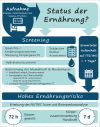[Assessment and technical monitoring of nutritional status of patients in intensive and intermediate care units : Position paper of the Section Metabolism and Nutrition of the German Interdisciplinary Association for Intensive and Emergency Medicine (DIVI)]
- PMID: 35482063
- PMCID: PMC9046715
- DOI: 10.1007/s00063-022-00918-4
[Assessment and technical monitoring of nutritional status of patients in intensive and intermediate care units : Position paper of the Section Metabolism and Nutrition of the German Interdisciplinary Association for Intensive and Emergency Medicine (DIVI)]
Abstract
At the time of admission to an intensive or intermediate care unit, assessment of the patients' nutritional status may have both prognostic and therapeutic relevance with regard to the planning of individualized medical nutrition therapy (MNT). MNT has definitely no priority in the initial treatment of a critically ill patient, but is often also neglected during the course of the disease. Especially with prolonged length of stay, there is an increasing risk of malnutrition with considerable prognostic macro- and/or micronutrient deficit. So far, there are no structured, evidence-based recommendations for assessing nutritional status in intensive or intermediate care patients. This position paper of the Section Metabolism and Nutrition of the German Interdisciplinary Association for Intensive and Emergency Medicine (DIVI) presents consensus-based recommendations for the assessment and technical monitoring of nutritional status of patients in intensive and intermediate care units. These recommendations supplement the current S2k guideline "Clinical Nutrition in Intensive Care Medicine" of the German Society for Nutritional Medicine (DGEM) and the DIVI.
Die Erhebung des Ernährungsstatus zum Zeitpunkt der Aufnahme im Intensiv- oder Intermediate Care Bereich hat sowohl prognostische als auch therapeutische Relevanz im Hinblick auf die Planung einer individualisierten medizinischen Ernährungstherapie (engl. „medical nutrition therapy“, MNT). Diese Planung wird im Rahmen der Erstversorgung eines vital bedrohlichen Krankheitsbilds nachvollziehbar nicht priorisiert, jedoch im weiteren Verlauf häufig auch oft nicht mehr angemessen durchgeführt. Vor allem bei längerer Verweildauer besteht das Risiko einer Mangelernährung mit Aufbau eines kumulativen, prognoserelevanten Makro- und/oder Mikronährstoffdefizits. Bisher gibt es für Patient*innen auf Intensiv- und Intermediate Care Einheiten keine strukturierten Empfehlungen zur Erhebung des Ernährungsstatus. Das vorliegende Positionspapier der Sektion Metabolismus und Ernährung der Deutschen Interdisziplinären Vereinigung für Intensiv- und Notfallmedizin (DIVI) beinhaltet konsensbasierte Empfehlungen zur Erfassung und zum apparativen Monitoring des Ernährungsstatus von Patient*innen auf Intensiv- und Intermediate Care Stationen. Diese Empfehlungen ergänzen die aktuelle S2k-Leitlinie „Klinische Ernährung in der Intensivmedizin“ der Deutschen Gesellschaft für Ernährungsmedizin (DGEM) und der DIVI.
Keywords: Critical illness; Guideline; Intensive care; Malnutrition; Nutrition.
© 2022. The Author(s).
References
-
- Hiura G, Lebwohl B, Seres DS. Malnutrition diagnosis in critically ill patients using 2012 Academy of Nutrition and Dietetics/American Society for Parenteral and Enteral Nutrition standardized diagnostic characteristics is associated with longer hospital and intensive care unit length of stay and increased in-hospital mortality. J Parenter Enteral Nutr. 2020;44:256–264. doi: 10.1002/jpen.1599. - DOI - PubMed
-
- Elke G, Hartl WH, Kreymann K, Adolph M, Felbinger TW, Graf T, de Heer G, Heller A, Kampa U, Mayer K, Muhl E, Niemann B, Rümelin A, Steiner S, Stoppe C, Weimann A, Bischoff SC. DGEM-Leitlinie: „Klinische Ernährung in der Intensivmedizin“. Aktuel Ernahrungsmed. 2018;43:341–408. doi: 10.1055/a-0713-8179. - DOI - PubMed
-
- DIVI (2010) Empfehlungen zur Ausstattung von Intensivstationen. https://www.divi.de/joomlatools-files/docman-files/publikationen/intensi.... Zugegriffen: 30.03.2022
Publication types
MeSH terms
LinkOut - more resources
Full Text Sources



